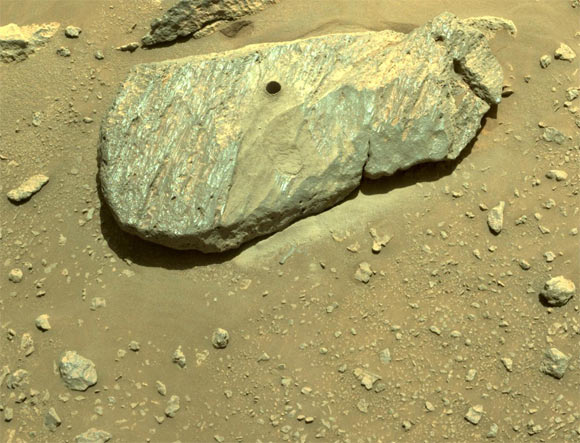The initial images captured by the Mastcam-Z instrument onboard NASA’s Perseverance rover show an intact Mars sample present in a sample tube after coring.
Source: Sci News
The September 1 coring is the second time that Perseverance has employed its Sampling and Caching System since landing in Jezero Crater on February 18, 2021.
“Perseverance’s Sampling and Caching System uses a rotary-percussive drill and a hollow coring bit at the end of its 2-m-long robotic arm to extract samples slightly thicker than a pencil,” said Dr. Jennifer Trosper, project manager at NASA’s Jet Propulsion Laboratory, and colleagues.
“Within the bit during coring is a sample tube.”
“After completing yesterday’s coring, Perseverance maneuvered the corer, bit, and open end of the sample tube in order to be imaged by the rover’s Mastcam-Z instrument.”
“The target for the sample collection attempt was a briefcase-size rock belonging to a ridgeline that is more than 900 m long and contains rock outcrops and boulders.”
This Mastcam-Z image shows a sample of Mars rock inside the sample tube on September 1, 2021 (the 190th sol, or Martian day, of the mission), shortly after the coring operation. The image was taken after coring concluded but prior to an operation that vibrates the drill bit and tube to clear the tube’s lip of any residual material. The bronze-colored outer-ring is the coring bit. The lighter-colored inner-ring is the open end of the sample tube, and inside is a rock core sample slightly thicker than a pencil. A portion of the tube’s serial number — 266 — can be seen on the top side of tube’s wall. Image credit: NASA / JPL-Caltech / ASU / MSSS.
The initial set of images from Mastcam-Z showed the end of a cored rock within the sample tube.
After taking these images, Perseverance began a procedure called ‘percuss to ingest,’ which vibrates the drill bit and tube for one second, five separate times. The movement is designed to clear the lip of the sample tube of any residual material.
The action can also cause a sample to slide down farther into the tube.
After the rover finished the percuss-to-ingest procedure, it took a second set of Mastcam-Z images.
In these images, the lighting is poor, and internal portions of the sample tube are not visible.
“The project got its first cored rock under its belt, and that’s a phenomenal accomplishment,” Dr. Trosper said.
“We determined a location, and selected and cored a viable and scientifically valuable rock. We did what we came to do.”
“We will work through this small hiccup with the lighting conditions in the images and remain encouraged that there is sample in this tube.”
Source: Sci News

































Leave a Comment
You must be logged in to post a comment.